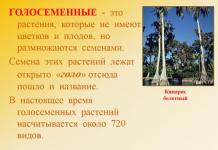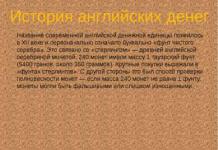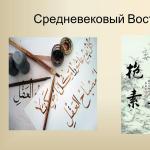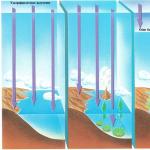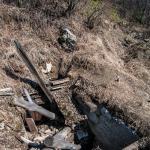The lesson is based on the textbook by V.V. for 6th grade. Beekeeper.
Lesson form: combined, using critical thinking technology
Stage of training on this topic: basic
Type of activity: search and reproductive
This topic introduces a new group of plants, the representatives of which reproduce in a new way, for students, using seeds and have cones of different sexes.
In Russia, 25% of the total area is occupied by coniferous forests, so this topic is of particular importance. Also, these forests are being cut down everywhere, so it is necessary to talk about their protection.
Messages are given to two students in advance: “Pine”, “Spruce”. Students are given the opportunity to learn in advance poems about nature conservation and F. Tyutchev, which are included in the outline. You can also draw a table in advance to save time. At the end of the lesson plan there is an appendix that can be used in class to demonstrate diversity. At all stages of the lesson, the presentation is used, which is available in the application.
Goal: to introduce students to the structural features of gymnosperms and their diversity.
- Find out which plants are gymnosperms.
- Show the difference between seed propagation and spore propagation.
- Consider the diversity of gymnosperms and their significance.
- To develop the ability to highlight the main thing, draw conclusions, work with a textbook and additional material. Develop skills in search work, observation, and accuracy when performing laboratory work.
- Caring for nature conservation. Aesthetic design of lessons and notebooks.
Equipment: herbarium material, spruce and pine cones, computer, multimedia, screen, handouts: crossword puzzle, labyrinth
Planned result:
- Students should know:
- Structural features of gymnosperms
- The structure of needles and cones of gymnosperms
- The importance and diversity of gymnosperms in nature and human life
- Students should be able to:
- Distinguish between types of conifers
- Name the characteristic features of gymnosperms.
Organizing time.
I. Testing knowledge on covered topics
Today we are moving on to studying new plants, the names of which you will recognize by solving this crossword puzzle. The crossword puzzle grid is distributed to each desk. Children work in pairs.
- Living organisms that have the characteristics of plants and animals. Separated into a separate kingdom.
- Body of multicellular lower plants
- Green plant pigment
- Another name for mushroom root
- A cell through which fungi and lower plants reproduce
- Moss germ cells
- Mutually beneficial cohabitation of living organisms
- Moss group
- Organism composed of algae and fungus
- The deepest seaweed
- The group of algae to which kelp belongs
- All living organisms are made of them
II. Main part
This is the topic of our lesson (record the topic)
Look at the title. What does it tell you?
Today you will learn: (tasks are shown on a slide and spoken out)
1. What plants belong to this group, their significance.
3. Does propagation by seeds give these plants an advantage?
5. We will carry out laboratory work to identify individual species
View slides. The task is given: write down the plants that belong to this group. Title on slides. The poem is read out by the teacher or student.
... Not what you think, nature:
Not a cast, not a soulless face -
She has a soul, she has freedom,
It has love, it has language... (F. Tyutchev)
While the viewing is going on, the teacher explains the meaning of the plants. Coniferous wood is used to make furniture, paper, musical instruments, pencils, and is used as firewood. Resin is used for rosin and turpentine. Coniferous fragrance is used to make creams, shampoo, and soap. Larch provides a person with wood that does not rot in water and is not inferior in strength to metal. The piles of the Troyan Bridge on the Danube, built from larch, survived for almost two millennia. Phytoncides are produced that kill microbes.
1. What do plants have in common? (conifers, evergreens).
The teacher adds: thuja, spruce, fir, yew, gnetums (vines), that conifers grow only in northern latitudes, and in South America and Australia, there are gymnosperms with scaly leaves, for example cypress, Ginkgo. More than 500 species.
A very ancient group. 150 million years ago they achieved their dominance. The first were cycads, which looked like a palm tree. The last flyleaf of the textbook.
Among them there are record holders. Long-livers: sequoia dendron - mammoth tree (6000 years), in California - bristlecone pines live 4600 years. The largest of them have their own names. In the trunk of the “Tree-House” (height 90 m, thickness 11 m) there is a summer house, and a road is built through the “Tree-Tunnel”. It is estimated that 25 wagons would be required to transport the General Sherman.
2. What are needles? Find the answer in the textbook (page 75)
- Are these plants higher or lower? Rationale.
- How do they reproduce?
- Why is seed propagation more profitable? Answer on your own or find the answer in the textbook.
- How the seeds lie. Showing the cones (we lead to the answer that the seeds lie openly on the surface of the scales). The teacher adds that cones are male and female. There is no flower.
Primary consolidation of knowledge.
- What have you learned about gymnosperms? A conclusion is drawn with the help of the teacher. Available on the slide in the presentation.
Conclusion: only trees, shrubs and vines. The seeds have a supply of substances, the embryo is protected. The seeds lie open on the surface of the scales. There are male and female cones. The needles have a dense skin and are covered with wax, so they evaporate little water and are adapted to unfavorable conditions.
Now we will do laboratory work and learn how to identify plants by their characteristics.
Laboratory work (page 79 ). “Study of the structure of needles.” I recommend considering only the needles of two plants (I don’t have enough time). For example, Scots pine and spruce.
Conclusion about the differences in needles. Done by students.
Student report about pine and spruce. The rest of the students fill out the table. The teacher helps with the first line. The second one is filled out independently after listening to the report. Slide
| Plant name | Living conditions | Cones | Peculiarities | Age |
| pine | photophilous In dry forests |
Males are greenish-yellow, collected in groups at the base of young shoots Female – reddish, solitary, woody |
Tall, slender, without lower branches Spreading in open areas |
350, 400 years |
| spruce | ||||
| larch | ||||
| juniper |
Homework: Fill out the table to the end.
III. Consolidation.
Questions for the class.
- What is the main difference between seed plants and spore plants?
- Why are conifers otherwise called gymnosperms?
- What conditions are necessary for the life of pine and spruce?
- What plants are gymnosperms?
- How do people use conifers? What does one get out of them?
Labyrinth. Shown on the slide. Distributed to each table. A textbook is used. Work in pairs .
Answer Key: 1, 6, 7, 8, 13, 14, 9, 10, 15, 19, 24, 20, 25.
Students independently check and give themselves a grade (if the maze is completed completely - “5”, 7-12 correct moves - “4”, less - “3”)
Final word:
No matter how widely these plants are used by humans. It is necessary to think about their protection. Conifers are being cut down everywhere. The taiga is getting poorer. At the same time, oxygen and water are becoming less and less. Conifers are not resistant to air pollution. That's why our industry is destroying them. The poem is on the slide. Read by heart by the student
We say in front of all the people:
To prolong nature's centuries,
Must help nature
Nature's friend is man.
So that the years rush by peacefully,
Century after century blossomed,
Be a friend to all nature
Every person should!
IV. Summarizing.
The diversity of gymnosperms is discussed using a multimedia presentation. The slide show with images of gymnosperms is commented on with a short message. I consider it necessary to introduce students to gymnosperms growing not only in Russia, but also in other countries.
Download:
Preview:
To use presentation previews, create a Google account and log in to it: https://accounts.google.com
Slide captions:
Features of organization Gymnosperms produce seeds. These are more advanced units of reproduction and dispersal than spores, since they contain an embryo and reserve nutrients necessary in the first stages of its development. Dense shells protect the seed from unfavorable factors, many of which are detrimental to spores. Seed plants acquired advantages in the struggle for existence, which determined their flourishing during the drying climate.
Ancestors of Gymnosperms: the oldest representatives of the fern division. It is among them that there are heterosporous tree-like forms with secondary wood, which could give rise to gymnosperms. Gymnosperms did not originate from true (typical) ferns, but from one of the lateral heterosporous branches of the oldest fern-like plants.
Gymnosperms have a stem, root and leaves. They form seeds with which they reproduce and spread. Gymnosperms are wind-pollinated plants; their reproduction does not depend on water. Thanks to this, seed plants are currently the conquerors of land. Gymnosperms have resin canals in the bark and wood filled with resin and essential oils. The needle-shaped or scaly leaves are covered with a tough cuticle. The stomata are immersed in the tissue, which reduces water evaporation.
The most common in Russia is Spruce Pine
Juniper
Siberian and Daurian larch
Fir and Siberian pine
Ephedra is a low-growing shrub
Cypress - a tree of the Mediterranean
Thuja grows there too
Cryptomeria is loved by the Chinese and Japanese
Conifers of the southern hemisphere. Araucaria
Velvichia amazing from the Namib Desert
Liana gnetum
Cycad
Ginkgo biloba
Consider pine and fir cones. Why are these plants called gymnosperms?
Male cones Female cones
Use of conifers Furniture and paper are made from coniferous wood; It is used in the construction of buildings, the manufacture of musical instruments, and pencils. Coniferous resin is used to produce rosin and turpentine. Coniferous fragrances are used in the manufacture of creams, shampoos, and soaps. Larch provides a person with wood that does not rot in water and is not inferior in strength to metal.
These plants form vast forests (taiga), and also decorate streets and city parks. Low resistance to air pollution.
On the topic: methodological developments, presentations and notes
lesson presentation "Diversity of angiosperms"
The world of angiosperms is diverse. Many flowering plants are used by humans. During the lesson, students will prove that any plant can be useful...
Presentation "Cellular structure of a plant" (lesson-game)
The lesson-game is aimed at reinforcing the topic “Cellular structure of plants.” The lesson includes: riddles, insert the missing word, plant cell, crossword...
Slide 1
Slide 2

Gynosperms are plants that do not have flowers or fruits, but reproduce by seeds. The seeds of these plants lie openly “barely”, hence the name. Currently, there are about 720 species of gymnosperms.
Swamp cypress
Slide 3

ADVANTAGES OF GYNOSPEMALS OVER SPOTED PLANTS
The reproduction process is not associated with water. The seeds contain a large supply of nutrients necessary to feed the seedling (spores contain very few nutrients, so they have poor viability)
Slide 4

Slide 5

The core of these plants is edible. In Japan, it is used to make cereal - sago. In Africa, cycads are called breadfruit. The cycad is the slowest growing tree; it grows 10 cm in 100 years.
Slide 6

Ginkgo is a living relic. Appeared on Earth 300 million years ago and went extinct at the same time as dinosaurs. Only one species has survived, which the Dutch accidentally discovered in Japan.
Slide 7

Slide 8

Translated from Japanese, ginkgo means silver apricot. Its seeds are valued as a medicinal product and an expensive delicacy.
Slide 9

Velvichia is amazing - it grows in deserts where not a drop of rain falls for years. The trunk is short and thick, similar to a stump. There are only two leaves, they never fall and grow throughout their lives. She has a long life of up to 1000 years
Slide 10

CONIFEROS
Pine
Top row, from left to right: Scots pine, black pine, hemlock, Lebanese cedar. Bottom row, from left to right: larch, plain fir, common spruce, blue spruce
Slide 11

PINE (350 – 400 YEARS)
The color of the bark is red-brown. Light-loving. Undemanding to the soil (can grow on sand, rocks and swamps). The needles are long, narrow, connected in twos. The root system is varied and well developed.
Slide 12

SPRUCE (250 – 300 YEARS)
The color of the bark is dark brown. Shade-tolerant plant. Grows in fertile and well-moistened soil. The needles are short, sharp, located singly on the shoots (live 7-9 years). The root system is less developed, the lateral roots are located in the surface layer.
Slide 13

The outside of the needles is covered with a dense skin, in which there are few stomata, so they evaporate little water and easily tolerate drought. In bark and wood there are resin passages - intercellular spaces filled with essential oil and resin. The resin protects plants from the penetration of microorganisms and insects. That's why they live long.
Slide 14

Reproduction of gymnosperms
Reproduction of gymnosperms occurs with the help of seeds, but unlike flowering plants, their seeds are not formed inside the fruit, but in peculiar organs - cones, which are formed on young shoots. Let's consider the reproduction of gymnosperms using the example of pine. Pine is a monoecious plant.
Slide 15

CONES
FEMALE Reddish, larger, rounded, located on the tops of young shoots. On the axis of the cone there are scales, on the inside of which there are ovules in pairs.
MALE Greenish-yellow, spikelet type, located at the base of young shoots. Two pollen sacs develop on the scales. Pollen ripens in them.
Slide 16

Pollination occurs in late May - early June with the help of wind. Pollen falls on the seed scales and they are glued together with resin. It takes 1 year from pollination to fertilization. The seeds ripen a year and a half after pollination, and spill out of the cones almost two years later. The seeds have membranous wings, thanks to which they are dispersed by the wind.
Slide 17

MEANING OF PINE
Pine trees release volatile substances that kill microbes, so the air in the pine forest is sterile
Slide 18

VALUE OF FIRE
Spruce wood is the main raw material for paper production. Spruce needles are six times richer in vitamin C than lemon. Stradivarius and Amati made their violins from spruce.
Slide 20

The seeds of the Siberian pine pine are “pine nuts”. They are tasty and very healthy, ripening for more than two years (27 months). In good years, you can collect up to two tons of seeds from 1 hectare. Cedar wood is a good material for musical instruments. Chests and cabinets made of cedar wood do not harbor moths, and milk does not sour for a long time in cedar dishes.
Slide 21

CEDAR
These are one of the most ancient trees. Nowadays, only 4 types of cedars have survived in nature: Lebanese, Himalayan, Atlas, and Cypriot. These are powerful, tall (40 m) trees, the pride and decoration of the countries where they grow. Therefore, the Lebanese cedar became the national symbol of this country and is depicted on the flag of Lebanon. Sarcophagi of Egyptian pharaohs are made of cedar wood
Cedar of Lebanon
Slide 23

Larch needles are soft and fall off every autumn like leaves - hence the name of the tree. And its wood is hard, heavy and very durable. It does not rot for a long time in soil and even water. The wooden tower of the Yakut fort, built from larch in the middle of the 17th century, has survived to this day.
Slide 24

CYPRESS
From left to right: evergreen cypress, western thuja, biota, Cossack juniper
Slide 25

CYPRESS
In the Caucasus, there is a legend about a girl named Cypress, who accompanied the groom on a long voyage and waited for him on the shore every evening. But the groom did not return, and then the girl turned into an “eternally waiting” slender cypress, from which all the other cypresses originated.
Slide 26

Alleys of cypress trees decorate many southern cities. One Italian city even passed a law that everyone who wants to build a house must plant a cypress tree.
There are examples of completely opposite attitudes towards cypress on the part of humans. In the 50s XX in the USSR they began to cut down cypress trees en masse and destroyed 75 thousand mature trees. Reason: This tree was accused of “spreading tuberculosis”
Slide 27

JUNIPER
The height of the plant is 10–12 m, although the height of some specimens reaches 17 meters. They can live up to 600 years and grow very slowly. Belief in the protective power of juniper was very strong, so that clouds of its fragrant smoke were sent after departing enemies (so that they would not return).
Slide 28

Abundant harvests of cones occur every 3–4 years. Infusions of them are used to increase appetite and serve as seasoning. Juniper produces 6 times more aromatic substances that kill bacteria than pine. In the places where it grows, the air is clean and healthy.
Slide 29

Yew
From left to right: yew (yew berry), araucariaceae (araucaria angustifolia, agathis), capitate tissaceae (Yew Fortune)
Slide 30

TISS
The wood of yew is extraordinary. People call this plant “negniyushka”. Yew wood does not rot either in air or in water and is preserved for centuries. Therefore, it was used for the construction of dams, water mills, and ships. Its strength brings to mind iron. Nails, arrows, spears, even cannonballs were made from it.
Slide 31

Yew grows slowly: for example, the height of a 1200-year-old tree near Mount Ai-Petri is only 10 meters. Yew wood is poisonous. Gardeners trimming yew hedges must work with long breaks, otherwise within half an hour they will begin to feel dizzy, dizzy, and nauseous.
Slide 32

SEQUOIA
The most gigantic plant inhabiting our planet. Sequoias got their name in honor of the Indian chief Sequoia from the Cherokee tribe, who created it at the beginning of the 19th century. alphabet for his people. And one of the types of sequoias is called mammoth tree for the resemblance of its crooked branches to the tusks of a mammoth.
Slide 33

Sequoia has an excellent red wood that is highly prized in carpentry. It is almost not affected by fire. Scientists have found that this tree needs forest fires; without them, sequoias would not have survived to this day. The fire, without causing much harm to the forest giants, burns out the undergrowth and pine needles lying on the ground.
Slide 34

Slide 35

THE IMPORTANCE OF GYNOSEPERS
They form organic substances and release oxygen. Coniferous forests delay snow melting and enrich the soil with moisture. Pine produces volatile substances that have an antibacterial effect. Valuable building and ornamental material (sequoia wood - mahogany). Spruce wood is a raw material for making paper. Turpentine, varnishes, alcohol, and plastics are obtained from conifers. Oil is obtained from the seeds of Siberian pine. Many conifers are used as ornamental plants.
Slide 36

BIOLOGICAL TASKS
OPTION 1. Deciduous trees - birch, linden, oak - shed their leaves completely in the winter, which preserves them from large losses of water. Conifers, with rare exceptions, are evergreens. How do spruce and pine tolerate winter “drought”? In coniferous forests, pine trunks have no branches almost to the very tops, while spruce trees lack branches only in the lower part of the trunks. What are the reasons for these differences? Seeds from pine cones fall out at the end of winter and beginning of spring. Does the time of seed dispersal have any significance in the life of a pine tree? If yes, which one?
OPTION 2. In spring, small reddish cones form at the tops of young pine shoots, and small yellow cones form at the base of young shoots. Which of these bumps are male and which are female? During a strong wind, spruce trees are torn out with their roots, and the top of the trunk of pines breaks off (about 1/3 of the height of the tree). How can such phenomena be explained? Pine is very often used in plantings to consolidate sand, but spruce is not suitable for this. What is this connected with?
The amazing world of plants growing on the planet never ceases to amaze us with its peculiarities and bizarre forms of manifestation. The origin of gymnosperms is controversial among scientists; the remains of gymnosperms - fern-like ancestors are found in the most ancient layers of the Mesozoic era. This is a small group that contains about 800 plant species.

Some interesting facts about gymnosperms.
Mostly g Historic plants are presented in the form of trees and, less commonly, shrubs, but there are varieties that cannot be attributed to this species. For example, this is a ginkgo plant whose leaves resemble maple leaves. It was widespread in Siberia, as evidenced by Jurassic deposits. Found in mountainous China.


Fertilization occurs with a long time delay. In some species of pine trees this period reaches from one to two years.

Trees belonging to this species often reach gigantic sizes. One example is the sequoia family Taxodiaceae, which, with an average height of about 100 meters, reaches a diameter of about 20 meters and a weight of about 1000 tons.

These are plants whose lifespan is several thousand years. After cutting down one tree, dance floors or restaurants are set up on the stump, and the study of redwood rings allows scientists to study climate change over hundreds and thousands of years.


Now practically exterminated, the British artificially maintain the population by turning the cultivation of living yew hedges into a national tradition.

Yew does not differ in height, two-hundred-year-old trees reach a height of 20-25 meters. .

Surprising is the fact that the tree has several tops. When one of the tops reaches a certain size, it dies off, and the other top continues to grow. The yew crown is dense and dense, so other plants do not grow under the tree

What is also unusual is gymnosperm tree cypress, the wood of which does not rot, and in the area where cypress trees grow, all harmful microorganisms are destroyed, which determines its medicinal properties, known since ancient times.
“Signs of Liliaceae” - Liliaceae Family. Plant taxonomy. By what characteristics can plants of the Dicotyledonous Class be distinguished? Answers to the test: May lily of the valley. Guess the plants. Head of cabbage. Think in pairs and express your impressions in one word. Distinctive features of the class Monocots. Although Alena is hiding behind a green twig, her red cheek is visible from afar.
“Gymnosperms” - Where are the seeds located in gymnosperms? Needles are modified needle-like leaves of coniferous plants. Gymnosperms include conifers. The cones contain seeds on hard scales. The structure of leaves of coniferous plants. Gymnosperms. Biology. 7th grade. The meaning of gymnosperms.
"Cotyledons" - The cruciferous family. Dicotyledons. The fruit is a berry (nightshade, tomatoes, potatoes, peppers). The inflorescence is a raceme. Petals - sail, oars, boat, 10 stamens. The fruit is a pod or pod. The fruit is a capsule (tobacco, aromatic tobacco, petunia, henbane). Plants are classified according to the number of cotyledons. Single flowers. Monocots have a fibrous root system;
“Gymnosperms” - Characteristics of Gymnosperms. Gymnosperms are also used by humans in their economic activities. The core of some tropical forms (for example, cycads) is eaten. Division Gymnosperms. The entire sailing fleet is built primarily from pine. The stomata are immersed in the leaf tissue, which reduces water evaporation.
"Lily" - Yellow. And many others... 3. Presentation on the topic LILY. 1. Spider mite. Aphid. Pink. Gymnasium No. 1596. There are also pests, such as aphids, scale insects, and spider mites. The bulbs suffer from hoverflies, mole crickets, and wireworms. Shield. White.
“Class Dicotyledonous” - The flower has a double perianth. The leaves are simple and compound. The fruit is an achene. Tomato. Family Solanaceae. Many asters form cushion-shaped forms. Class Dicotyledons. Family Asteraceae (Asteraceae). Lupine. The fruit is either a berry or a capsule. Rose hip. The leaves are simple. The flowers of Asteraceae are small and have a double perianth.
There are a total of 13 presentations in the topic
